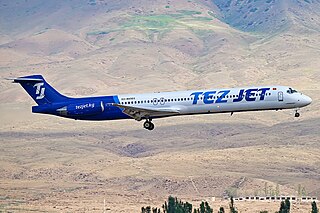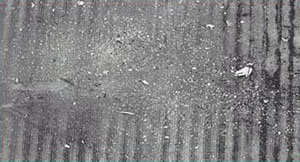
The Lockheed L-1011 TriStar is an American medium-to-long-range, wide-body trijet airliner built by the Lockheed Corporation. It was the third wide-body airliner to enter commercial operations, after the Boeing 747 and the McDonnell Douglas DC-10. The airliner has a seating capacity of up to 400 passengers and a range of over 4,000 nautical miles. Its trijet configuration has three Rolls-Royce RB211 engines with one engine under each wing, along with a third engine center-mounted with an S-duct air inlet embedded in the tail and the upper fuselage. The aircraft has an autoland capability, an automated descent control system, and available lower deck galley and lounge facilities.

The McDonnell Douglas DC-10 is an American trijet wide-body aircraft manufactured by McDonnell Douglas. The DC-10 was intended to succeed the DC-8 for long-range flights. It first flew on August 29, 1970; it was introduced on August 5, 1971, by American Airlines.

The Convair 880 was an American narrow-body jet airliner produced by the Convair division of General Dynamics. It was designed to compete with the Boeing 707 and Douglas DC-8 by being smaller but faster, a niche that failed to create demand. When it was first introduced, some in aviation circles claimed that at 615 mph (990 km/h), it was the fastest jet transport in the world. Only 65 Convair 880s were produced over the lifetime of the production run from 1959 to 1962, and General Dynamics eventually withdrew from the airliner market after considering the 880 project a failure. The Convair 990 Coronado was a stretched and faster variant of the 880.

Turkish Airlines Flight 981 (TK981/THY981) was a scheduled flight from Istanbul Yeşilköy Airport to London Heathrow Airport, with an intermediate stop at Orly Airport in Paris. On 3 March 1974, the McDonnell Douglas DC-10 operating the flight crashed into the Ermenonville Forest, 37.76 kilometres (23.46 mi) outside Paris, killing all 335 passengers, and 11 crew on board. The crash was also known as the Ermenonville air disaster. Flight 981 was the deadliest plane crash in aviation history until 27 March 1977, when 583 people died in the collision of two Boeing 747s in Tenerife. It remains the deadliest single-aircraft accident without survivors, the second hull loss and the deadliest accident involving the McDonnell Douglas DC-10, and the deadliest aviation accident to occur in France.

The McDonnell Douglas MD-80 is a series of five-abreast single-aisle airliners developed by McDonnell Douglas. It was produced by the developer company until August 1997 and then by Boeing Commercial Airplanes. The MD-80 was the second generation of the DC-9 family, originally designated as the DC-9-80 and later stylized as the DC-9 Super 80 . Stretched, enlarged wing and powered by higher bypass Pratt & Whitney JT8D-200 engines, the aircraft program was launched in October 1977. The MD-80 made its first flight on October 18, 1979, and was certified on August 25, 1980. The first airliner was delivered to launch customer Swissair on September 13, 1980, which introduced it into service on October 10, 1980.

Delta Air Lines Flight 1141 was a scheduled domestic passenger flight between Dallas/Fort Worth, Texas and Salt Lake City, Utah. On August 31, 1988, the flight, using a Boeing 727-200 series aircraft, crashed during takeoff, resulting in 14 deaths and 76 injuries of the 108 on board.

The Pratt & Whitney PW4000 is a family of dual-spool, axial-flow, high-bypass turbofan aircraft engines produced by Pratt & Whitney as the successor to the JT9D. It was first run in April 1984, was FAA certified in July 1986, and was introduced in June 1987. With thrust ranging from 50,000 to 99,040 lbf, it is used on many wide-body aircraft.

American Eagle Flight 4184, officially operating as Simmons Airlines Flight 4184, was a scheduled domestic passenger flight from Indianapolis, Indiana, to Chicago, Illinois, United States. On October 31, 1994, the ATR 72 performing this route flew into severe icing conditions, lost control and crashed into a field. All 68 people aboard were killed in the high-speed impact.
Aircraft upset is an unacceptable condition, in aircraft operations, in which the aircraft flight attitude or airspeed is outside the normally intended limits. This may result in the loss of control (LOC) of the aircraft, and sometimes the total loss of the aircraft itself. Loss of control may be due to excessive altitude for the airplane's weight, turbulent weather, pilot disorientation, or a system failure.

TWA Flight 843 was a scheduled Trans World Airlines passenger flight that crashed after an aborted takeoff from John F. Kennedy International Airport to San Francisco International Airport (California) in July 1992. Despite an intense fire after the crash, the crew was able to evacuate all 280 passengers from the aircraft. There was no loss of life, although the aircraft was destroyed by the fire.

On May 5, 1983, a Lockheed L-1011 TriStar, registration N334EA, operating as Eastern Air Lines Flight 855 en route from Miami International Airport to Nassau International Airport, experienced the loss of all three engines near Miami, Florida. The flight crew succeeded in restarting one engine in time to safely land the aircraft at Miami International Airport.
Several aviation incidents and accidents have occurred in which the control surfaces of an aircraft became disabled, often due to failure of hydraulic systems or the flight control system. Other incidents have occurred where controls were not functioning correctly prior to take-off, either due to maintenance or pilot error, and controls can become inoperative from extreme weather conditions. Aircraft are not designed to be flown in such circumstances; however, a small number of pilots have had some success in flying and landing aircraft with disabled controls.

Northwest Airlines Flight 85 was a scheduled international passenger flight from Detroit Metropolitan Wayne County Airport in the United States to Narita International Airport in Japan. On October 9, 2002, while over the Bering Sea, the Boeing 747-400 experienced a lower rudder hardover event, which occurs when an aircraft's rudder deflects to its travel limit without crew input. The 747's hardover gave full left lower rudder, requiring the pilots to use full right upper rudder and right aileron to maintain attitude and course.

On May 30, 1972, Delta Air Lines Flight 9570 crashed while attempting to land at the Greater Southwest International Airport (GSW) in Fort Worth, Texas during a training flight. All four occupants aboard the training flight were killed. The crash was determined to be caused by the aircraft flying through wake turbulence, and led to sweeping changes in procedures for maintaining minimum safe distance behind aircraft that generate substantial wake turbulence.

American Airlines Flight 383 was a scheduled passenger flight from O'Hare International Airport in Chicago, Illinois to Miami International Airport. On October 28, 2016, the Boeing 767-300ER operating the flight suffered an engine fire during takeoff. The crew aborted their takeoff, evacuating everyone on board, of whom 21 were injured. The plane was a write-off.

Pan Am Flight 799 was an international cargo flight from Los Angeles International Airport to Cam Ranh Airport in South Vietnam that crashed on December 26, 1968, near Anchorage, Alaska. The aircraft involved was a Boeing 707-321C aircraft operated by Pan American World Airways. All three crew members died in the crash.

On February 20, 2021, United Airlines Flight 328 (UA328/UAL328), a scheduled U.S. domestic passenger flight from Denver to Honolulu, suffered what was technically ruled a contained engine failure despite shedding large pieces of debris, approximately four minutes after takeoff from Denver International Airport (DEN). Parts departing from the engine cowling of the Boeing 777-222 aircraft resulted in a debris field at least 1 mile (1.6 km) long over suburban residential areas of Broomfield, Colorado. Falling debris was recorded by eyewitnesses using smartphone cameras and a dash cam. Debris fell through the roof of a private home and significantly damaged a parked vehicle.

Tower Air Flight 41 was a scheduled domestic passenger flight from John F. Kennedy International Airport (JFK) in New York City, to Miami International Airport (MIA) in Florida. On December 20, 1995, the Boeing 747-100 operating the flight veered off the runway during takeoff from JFK. All 468 people on board survived, but 25 people were injured. The aircraft was damaged beyond repair and written off, making the accident the 25th hull loss of a Boeing 747. The National Transportation Safety Board (NTSB) concluded that the captain had failed to reject the takeoff in a timely manner.

Japan Air Lines Cargo Flight 46E was a scheduled cargo flight on 31 March 1993, operated by Evergreen International Airlines, on behalf of Japan Air Lines, from Anchorage International Airport, in Anchorage, Alaska, to O'Hare International Airport, in Chicago. After departure, while climbing through 2,000 feet, the pylon for engine two detached, causing the whole engine to fall off the wing. The pilots managed to land the 747 back at Anchorage without further incident.

















